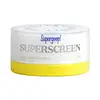What's inside
What's inside
 Key Ingredients
Key Ingredients

 Benefits
Benefits

 Concerns
Concerns

 Ingredients Side-by-side
Ingredients Side-by-side

Butyl Methoxydibenzoylmethane 2.5%
UV AbsorberHomosalate 8%
Skin ConditioningEthylhexyl Salicylate 5%
UV AbsorberWater
Skin ConditioningCarthamus Tinctorius Oleosomes
EmollientGlycerin
HumectantC12-15 Alkyl Benzoate
AntimicrobialPolyester-7
Skin ConditioningAmmonium Acryloyldimethyltaurate/Vp Copolymer
Neopentyl Glycol Diheptanoate
EmollientCarthamus Tinctorius Seedcake Extract
Skin ProtectingAphanizomenon Flos-Aquae Extract
HumectantInulin Lauryl Carbamate
Emulsion StabilisingXanthan Gum
EmulsifyingBiosaccharide Gum-4
Skin ConditioningCerium Oxide
Platinum Powder
Abrasive1,2-Hexanediol
Skin ConditioningEthylhexylglycerin
Skin ConditioningPhenethyl Alcohol
MaskingChlorphenesin
AntimicrobialButyl Methoxydibenzoylmethane 2.5%, Homosalate 8%, Ethylhexyl Salicylate 5%, Water, Carthamus Tinctorius Oleosomes, Glycerin, C12-15 Alkyl Benzoate, Polyester-7, Ammonium Acryloyldimethyltaurate/Vp Copolymer, Neopentyl Glycol Diheptanoate, Carthamus Tinctorius Seedcake Extract, Aphanizomenon Flos-Aquae Extract, Inulin Lauryl Carbamate, Xanthan Gum, Biosaccharide Gum-4, Cerium Oxide, Platinum Powder, 1,2-Hexanediol, Ethylhexylglycerin, Phenethyl Alcohol, Chlorphenesin
Water
Skin ConditioningDimethicone
EmollientIsododecane
EmollientButylene Glycol
HumectantBis-PEG-18 Methyl Ether Dimethyl Silane
EmollientGlycerin
HumectantLaminaria Saccharina Extract
Skin ProtectingPolygonum Cuspidatum Root Extract
AntioxidantSaccharomyces Lysate Extract
HumectantCucumis Sativus Fruit Extract
EmollientHordeum Vulgare Extract
EmollientHelianthus Annuus Seedcake
AbrasiveCaffeine
Skin ConditioningTrehalose
HumectantSodium Hyaluronate
HumectantTocopheryl Acetate
AntioxidantPolysilicone-11
Silica
AbrasivePropylene Glycol Dicaprate
EmollientOleth-10
EmulsifyingLactobacillus Ferment
Skin ConditioningLaureth-23
CleansingLaureth-4
EmulsifyingAmmonium Acryloyldimethyltaurate/Vp Copolymer
Carbomer
Emulsion StabilisingCaprylyl Glycol
EmollientHexylene Glycol
EmulsifyingTromethamine
BufferingDisodium EDTA
Phenoxyethanol
PreservativeCI 19140
Cosmetic ColorantCI 14700
Cosmetic ColorantCI 15985
Cosmetic ColorantWater, Dimethicone, Isododecane, Butylene Glycol, Bis-PEG-18 Methyl Ether Dimethyl Silane, Glycerin, Laminaria Saccharina Extract, Polygonum Cuspidatum Root Extract, Saccharomyces Lysate Extract, Cucumis Sativus Fruit Extract, Hordeum Vulgare Extract, Helianthus Annuus Seedcake, Caffeine, Trehalose, Sodium Hyaluronate, Tocopheryl Acetate, Polysilicone-11, Silica, Propylene Glycol Dicaprate, Oleth-10, Lactobacillus Ferment, Laureth-23, Laureth-4, Ammonium Acryloyldimethyltaurate/Vp Copolymer, Carbomer, Caprylyl Glycol, Hexylene Glycol, Tromethamine, Disodium EDTA, Phenoxyethanol, CI 19140, CI 14700, CI 15985
 Reviews
Reviews

Ingredients Explained
These ingredients are found in both products.
Ingredients higher up in an ingredient list are typically present in a larger amount.
Ammonium Acryloyldimethyltaurate/Vp Copolymer (let's call it AAVC for short) is a synthetically created polymer. It's used as a film-forming agent and used to thicken the consistency of products.
AAVC is able to increase the consistency and viscosity of products due to its large molecule size. It also prevents ingredients from separating.
Glycerin is already naturally found in your skin. It helps moisturize and protect your skin.
A study from 2016 found glycerin to be more effective as a humectant than AHAs and hyaluronic acid.
As a humectant, it helps the skin stay hydrated by pulling moisture to your skin. The low molecular weight of glycerin allows it to pull moisture into the deeper layers of your skin.
Hydrated skin improves your skin barrier; Your skin barrier helps protect against irritants and bacteria.
Glycerin has also been found to have antimicrobial and antiviral properties. Due to these properties, glycerin is often used in wound and burn treatments.
In cosmetics, glycerin is usually derived from plants such as soybean or palm. However, it can also be sourced from animals, such as tallow or animal fat.
This ingredient is organic, colorless, odorless, and non-toxic.
Glycerin is the name for this ingredient in American English. British English uses Glycerol/Glycerine.
Learn more about GlycerinWater. It's the most common cosmetic ingredient of all. You'll usually see it at the top of ingredient lists, meaning that it makes up the largest part of the product.
So why is it so popular? Water most often acts as a solvent - this means that it helps dissolve other ingredients into the formulation.
You'll also recognize water as that liquid we all need to stay alive. If you see this, drink a glass of water. Stay hydrated!
Learn more about Water